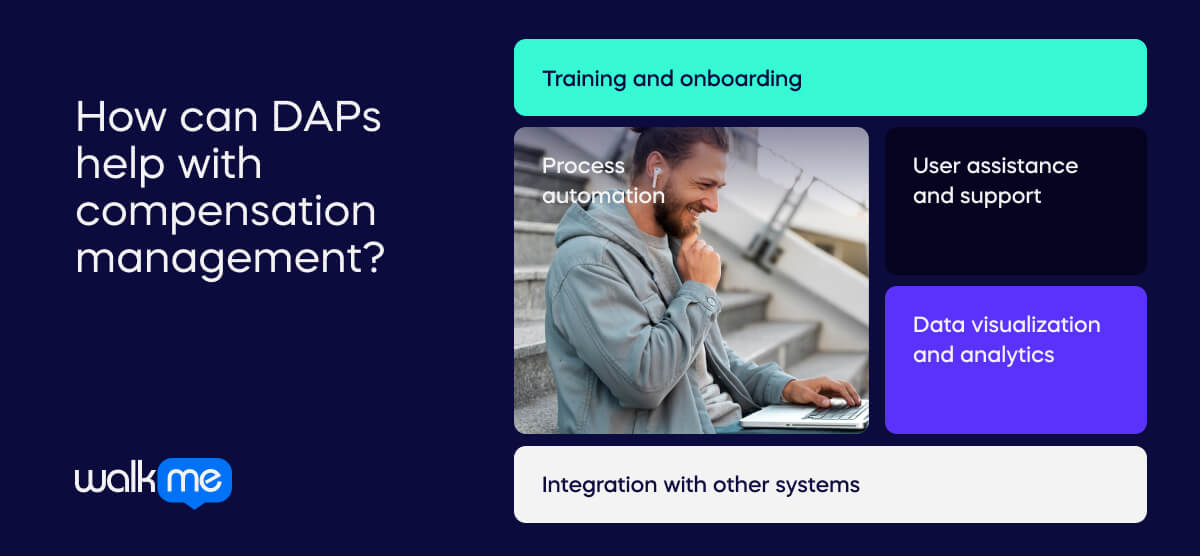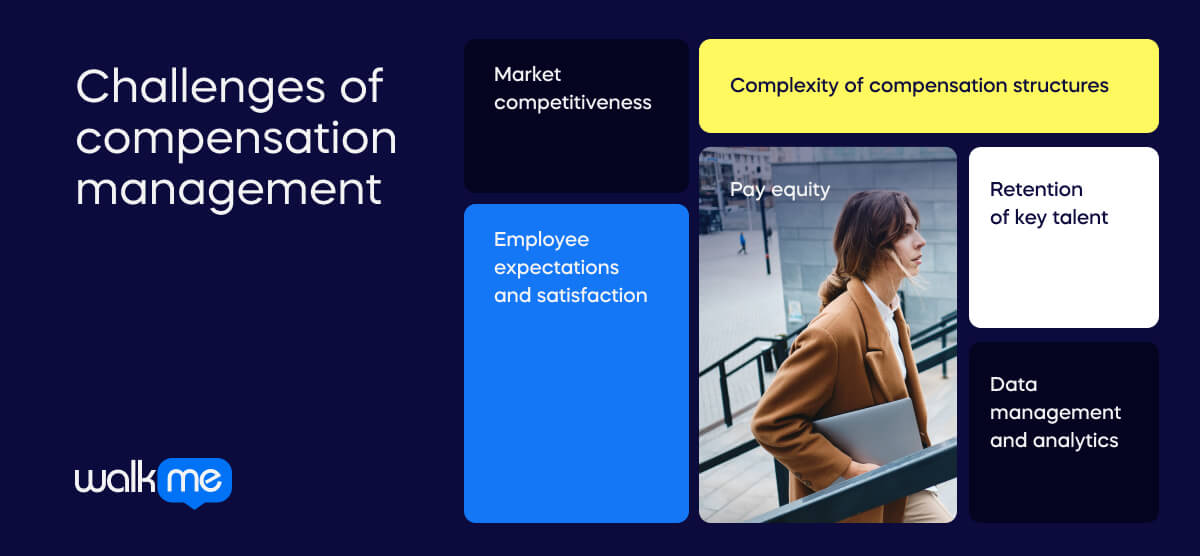What is compensation management?
Compensation management is the strategic process of designing, implementing, and administering the pay structure and benefits package for employees within an organization. It involves determining the appropriate compensation levels for different roles based on job responsibilities, market trends, employee performance, and organizational budget constraints.

Table of contents
The primary objectives of compensation management include:
- Attracting and retaining talented employees
- Motivating high performance
- Ensuring fairness in pay among employees within the organization
- Maintaining external competitiveness
Key components of compensation management include:
- Job analysis and evaluation: Assessing the value and complexity of various organizational roles to establish a fair and equitable pay structure.
- Salary surveys: Researching industry benchmarks and competitor compensation practices to ensure the organization’s pay rates are competitive.
- Performance management: Linking compensation to individual and team performance through performance evaluations, merit increases, bonuses, and incentives.
- Benefits administration: Managing employee benefits such as health insurance, retirement plans, paid time off, and other perks to enhance the overall compensation package.
- Legal compliance: Ensuring that compensation practices adhere to relevant labor laws and regulations, including minimum wage laws, overtime regulations, and anti-discrimination laws.
How can DAPs help with compensation management?

A digital adoption platform (DAP) such as WalkMe can significantly enhance the efficiency, effectiveness, and user experience of the compensation management process by:
- Providing training and onboarding support
- Automating processes
- Offering user assistance and support
- Providing data visualization and analytics
- Integrating with other systems
Demand for streamlined processes is high – a Gartner survey indicates that 56% of HR leaders say their technology solutions and strategy do not meet current and future business needs. With that in mind, let’s take a closer look at how DAPs can help HR professionals with compensation management:
Training and onboarding
- Smart Walk-Thrus: WalkMe can create interactive, step-by-step guides within the compensation management software. These guides help HR professionals navigate the system effectively during training and onboarding.
- ShoutOuts: The platform can deliver targeted messages to HR professionals, highlighting essential features and best practices related to compensation management.
- Surveys: Users can configure the DAP to collect feedback from HR professionals during their training, ensuring continuous improvement.
Process automation
- Automated workflows: WalkMe can automate repetitive tasks, such as updating employee records, calculating salaries, and generating reports. This reduces manual effort and minimizes errors.
User assistance and support
- ShoutOuts: These targeted messages or announcements can be tailored to address compensation changes. For example, you can notify employees about upcoming performance reviews or bonus payouts.
- Contextual help: WalkMe provides real-time assistance within the application. SmartTips and contextual guidance appear when HR professionals encounter challenges, helping them resolve issues without external support.
Data visualization and analytics
- Interactive dashboards: WalkMe can provide real-time dashboards using the compensation management software. These dashboards display key metrics such as average salary, bonus distribution, and performance-based incentives. HR professionals can monitor trends and identify outliers.
Integration with other systems
- Seamless data flow: The DAP easily integrates with payroll systems, performance management tools, and benefits platforms. When an HR professional updates compensation data, WalkMe ensures that the changes flow seamlessly across all relevant systems. This eliminates manual data entry and reduces errors.
- Cross-platform workflows: WalkMe guides HR professionals through end-to-end processes. For example, when adjusting compensation during performance reviews, WalkMe can assist in updating performance scores, calculating bonuses, and syncing data across systems.
Use cases for compensation management
Compensation management in business
Here are three examples of how compensation management can manifest in various business scenarios:
New hire compensation package
When a company hires a new employee, compensation management comes into play to determine the appropriate salary and benefits package for the position. This involves conducting market research to establish competitive pay rates for similar roles, considering the candidate’s qualifications and experience, and negotiating the terms of the offer. Compensation management ensures that the company offers a competitive package that attracts top talent while aligning with budgetary constraints and internal equity considerations.
Performance-based bonuses
Many companies use performance-based bonuses to reward employees for contributing to the organization’s success. Compensation management is involved in designing and implementing these bonus programs, which may include setting performance targets, defining bonus eligibility criteria, and determining the calculation method for bonus payouts. Compensation management incentivizes employees to achieve their goals and aligns their efforts with the company’s objectives by tying bonuses to individual or team performance metrics.
Merit increases and promotions
Compensation management also governs awarding merit increases and promotions to employees based on their performance, skills, and organizational contributions. This involves conducting performance evaluations, identifying high-performing employees, and determining the appropriate salary adjustments or promotions based on predefined criteria or guidelines. Compensation management ensures that salary increases and promotions are fair, consistent, and reflective of employees’ contributions, helping to retain top talent and motivate continued high performance. In this regard, an effective compensation management strategy is very effective – especially as Gartner reveals that 86% of HR leaders believe the company career paths aren’t clear for many workers.
What is the 3P approach to compensation management?
The 3P approach to compensation management integrates principles of pay equity, pay competitiveness, and pay alignment with performance. It ensures that organizations effectively manage their compensation practices fairly, competitively, and performance-driven. Let’s take a look at each principle in turn:
Pay equity
Pay equity ensures fairness and consistency in how employees are compensated within an organization. This involves establishing clear and transparent criteria for determining salaries and wages, such as job responsibilities, skills, experience, and performance. Pay equity aims to eliminate gender, racial, or other forms of discrimination in compensation practices and ensure that employees receive fair and equitable pay for similar work.
Pay competitiveness
Pay competitiveness involves benchmarking salaries and wages against external market data to ensure that an organization’s compensation packages remain competitive within its industry and geographic location. By monitoring market trends and salary surveys, organizations can adjust their pay structures to attract and retain top talent while managing costs effectively. Pay competitiveness helps organizations remain competitive in the labor market and avoid losing valuable employees to competitors offering higher compensation.
Pay alignment with performance
Pay alignment with performance emphasizes linking compensation directly to individual and organizational performance. This involves establishing performance metrics and goals aligned with the organization’s strategic objectives and rewarding employees based on their contributions to achieving those goals. By tying pay to performance, organizations can motivate employees to perform at their best, drive organizational success, and effectively allocate compensation resources.
Advantages of compensation management

Compensation management offers several advantages for both organizations and employees:
Attract and retain talent
Competitive compensation packages can help organizations attract top talent in the industry and retain existing employees. When employees feel fairly compensated for their skills, experience, and contributions, they are likelier to remain with the organization than seek employment elsewhere.
Motivate performance
Compensation management enables organizations to tie pay to performance through merit increases, bonuses, and incentive programs. By rewarding high performers with financial incentives, organizations can motivate employees to achieve their goals, drive productivity, and contribute to the company’s success.
Enhance employee engagement
Fair and transparent compensation practices contribute to higher employee engagement and job satisfaction. When employees perceive that their compensation is aligned with their efforts and contributions, they are more likely to feel valued and engaged in their work, leading to increased morale and productivity.
Support organizational objectives
Compensation management allows organizations to align their compensation strategies with their business objectives. By linking pay to performance metrics and strategic goals, organizations can ensure that compensation resources are allocated in a way that drives desired outcomes and supports the company’s long-term success.
Improve performance management
Compensation management provides a framework for evaluating and rewarding employee performance. By establishing clear performance expectations and linking compensation to performance outcomes, organizations can improve their performance management processes and foster a culture of accountability and continuous improvement.
Ensure compliance
Effective compensation management helps organizations ensure compliance with relevant labor laws and regulations governing compensation practices. By staying up-to-date with legal requirements and industry standards, organizations can minimize the risk of non-compliance and potential legal liabilities related to compensation.
Increase employee loyalty
When employees feel fairly compensated and rewarded for their contributions, they are likelier to develop a sense of loyalty to the organization. This loyalty can result in higher levels of employee commitment, reduced turnover, and a more stable workforce over time.
Challenges of compensation management

While compensation management offers numerous benefits, it also presents several challenges for organizations to navigate:
Market competitiveness
Ensuring that compensation packages remain competitive in the market can be challenging, especially in industries with high demand for skilled talent. Market fluctuations, changes in industry trends, and competitor actions can all impact the organization’s ability to attract and retain top talent while managing costs.
Pay equity
Achieving and maintaining pay equity across the organization can be complex, particularly in large and diverse workforces. Addressing disparities in pay based on factors such as gender, race, or other demographics requires careful analysis of compensation data and proactive measures to identify and rectify any inequities.
Complexity of compensation structures
Designing and administering complex compensation structures, such as variable pay plans, equity-based compensation, and incentive programs, can be challenging. Ensuring these structures are transparent, understandable, and aligned with organizational goals requires careful planning and communication.
Employee expectations and satisfaction
Meeting employees’ expectations regarding compensation and benefits can be challenging, especially in diverse and multi-generational workforces. Employees may have different preferences and priorities regarding compensation, requiring organizations to offer flexible and customizable compensation packages to accommodate varying needs and preferences.
Retention of key talent
Retaining key talent in a competitive market requires organizations to continuously assess and adjust their compensation strategies to meet employees’ evolving needs and expectations. Failure to retain key talent can result in increased turnover, loss of institutional knowledge, and disruptions to business operations.
Data management and analytics
Effectively managing and analyzing compensation data to inform decision-making can be challenging, especially for organizations with disparate systems and data sources. Implementing robust data management and analytics capabilities is essential for organizations to gain insights into compensation trends, identify areas for improvement, and make informed decisions about compensation strategy and practices.
The future of compensation management
Compensation management ensures fair and competitive employee remuneration while aligning with organizational goals. We have delved into various aspects of compensation management, including its definition, the role of Digital Adoption Platforms (DAPs) in enhancing its efficiency, its application in diverse business scenarios, the three key principles guiding it, and its advantages and challenges. Organizations can optimize their processes, enhance employee satisfaction, and drive overall performance by understanding the significance of compensation management and leveraging tools like DAPs. Looking ahead, the future of compensation management appears promising with the continued integration of digital solutions. Digital Adoption Platforms, in particular, offer unprecedented opportunities to streamline compensation processes, improve decision-making through data analytics, and enhance employee engagement by providing intuitive interfaces for understanding and managing compensation structures. As organizations increasingly embrace digital transformation, the role of DAPs in compensation management is poised to expand, offering innovative solutions to address evolving needs and challenges. By embracing these advancements, businesses can stay ahead of the curve and create a more agile and competitive workforce, ultimately driving success in the ever-changing landscape of modern business.